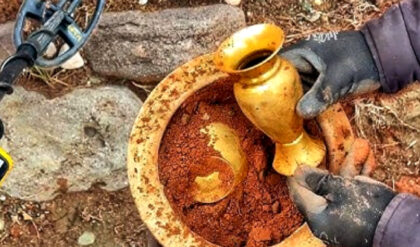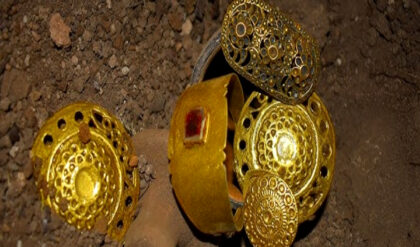Ancient Greek Girl Buried With A Crown of Ceramic Flowers, Patras, 300-400 BC, from Museum of Patras, September 5, 2013//Credit: Wikimedia Commons-Fred Martin Kaaby-CC-BY-SA-3.0 The skull of an Ancient Greek girl with a ceramic flower wreath has been discovered. These remains have been dated circa 400 to 300 B.C. This skull currently resides in The New Archaeological Museum of Patras in Greece.

This fossilized cranium is among a featured collection of the pates of women and girls found in the North Cemetery in Patras in the Hellenistic period. Patras is presently Greece’s third-largest city, the regional capital of Western Greece in the northern Peloponnese.
This period of history under consideration is one of Greek expansion and conquest. The collection is dated roughly from the time of the death of Alexander the Great (323 BCE) to the rise of Augustus in Rome (31 BCE).

What is archaeology? How can this ancient Greek girl wearing a ceramic wreath be characterized? Some scholars of archaeology are dynamic storytellers, or they may ask so many conflicting questions we may get bored. Their presentation may be about little more than nothing. A sense of humor helps reveal more than dry bones and broken pottery.

It is a good question to ask on International Archaeology Day (or any day of the year). What is this excavatable field of inquiry all about? Anytime an archaeologist examines ancient remains, they have certain goals in mind. They wish to document and explain the origins of human cultures. Desiring to understand cultural histories and record evolution, archaeologists thus study behavior and ecology.
Is archaeology useful? A focus on prehistoric and historical times is usually measured by the search for objectivity in asking many questions. Nevertheless, contemporary society finds all this useful when it contributes not simply to education but identity and community formation. These cannot be separated from politics or how power and society’s institutions are arranged, challenged, and justified. Has humanity evolved for the better because of archaeology and its contributions?
As the world becomes more ecologically aware, the overlap between archaeology and paleontology increases in importance. The difference between the former and the latter is that paleontology focuses on all life forms. Whether with social or deep ecological views, we begin to comprehend that human development cannot be separated from other species and dynamics of the planet.
Before digging, archaeologists research the historical background of the area to be considered. They survey the land for features and challenges. Preliminarily, and at regular intervals, subsurface testing is followed by written reports. Scholars hope that something profound can be discovered for historical and social interpretation.

Why buried with the wreath of ceramic flowers? Focusing on the remains of this girl, who obviously did not live to become an adult, allows us to speculate on biological evolution, the meanings of Greek youth in her epoch, and the path girls take in going from childhood to womanhood.
We can consider marriage rituals, religion, gender roles, sexuality, and children’s rites of passage. How did her community value nature and the arts? These are only beginnings. And these instincts become more specific as a product of the historical research one does before digging for bones or the remnants of art or tools.
How to evaluate child brides? Child brides were a feature of Greek antiquity in the era under consideration, which might indicate that young girl with the wreath was one as well.
Ancient child brides cannot only be meditated on from a modern human rights lens. First of all, such frameworks are not always sensitive to peripheral cultures in the world. Still, empathy is valid.
A girl in her middle or teenage years that has gone through puberty is not the same biologically as a preteen, and, if modern science suggests the brain doesn’t mature biologically until the mid to late twenties, then a preteen bride or even a late teen bride would be at a disadvantage with an older husband in terms of social equality.
The Ancient and modern problem of social equality The story of this ancient Greek girl can have thrust upon it patriarchy, sexuality, childbearing, and the meanings of marriage. Is marriage about love? If middle-aged men and women have a difficult time successfully navigating relationships today, what does maturity really mean?
In societies distinguished by artisans and peasant farmers, we might think of social responsibility and the age of awareness differently. Further, in ancient and modern times, the families of young girls, especially when poor, are concerned about their economic future. Most loving families take pride and feel joyful when their children get ready to start their own families.
Often, this means children will eventually have children of their own. New grandparents tend to be euphoric. They all of a sudden look at their gray hairs contemptuously. Still, in ancient times, there were very few nuclear families. This child was part of an extended community, and a village had probably raised her.
Perhaps, when she was buried, a crown was placed on her head, lamenting she died before she was married. Maybe the crown suggested a royal status—whether in fact or aspirationally. How humans are buried can say more about those who organize their funerals than the actual personality who is deceased. Clearly, someone cared about this girl, and, if she did die on the day of her marriage, it was a heartbreaking farewell.
Significance of ceramics in Greece and the Ancient world Ceramics were of great magnitude in Greece and the ancient world. There are ceramic figures discovered in Greece that have been preserved and dated that are at least 2,500 years old. This girl’s ceramic wreath is in that range.
It appears the wreath was an artistic depiction of myrtle flowers. Wreaths in the ancient Greek world can convey many meanings from victory to death. Myrtle is the sacred Greek plant of the goddess Aphrodite. Hermes fashioned his magic sandals from myrtle branches.
A wreath of fragrant myrtles Wreaths for the ancients were made of flowers, natural olive leaves, laurel leaves and even gold. Fragrant myrtle is associated with both love and death in the ancient Greek world. This could suggest the young girl was not a child bride but had simply died before her time. The myrtle tree was originally a tree on which the ancient Greek tragic hero, Hippolytus, in flight from Athens caught the chariot reins and was dragged to death by his horses. Perhaps in popular memory, this wreath signified tragedy just as much as love and marriage.
Myrtle-nymphs were prophetesses who taught the god Aristaeus, son of Apollo and Gyrene, the useful arts of making cheese, building beehives, and cultivating olives. Aphrodite, a very early Greek goddess of love and spring, seems to have initially been called Murcia, a deity that was later interpreted as Myrtea, goddess of myrtles. Could the wreath convey the young girl was an emerging gifted artisan?
Sacred myrtle grew in the groves at Eleusis when the initiates to the religious mysteries trolled there, wearing the leaves as wreaths. Myrtle, along with mint and rosemary, was burned from very early times at funerals. Then again, the myrtle wreath may just be a common rite of the dead.
A hidden or complex fate Greek philosopher Theophrastus, however, in his On Moral Characters, written in the later fourth century B.C., chides those superstitious Greeks who on the fourth and seventh days of each month buy myrtle boughs to garland their household gods. The myrtle wreath could, therefore, be part of an offering to the gods on the fated young girl’s behalf.
In the first century A.D., Pliny reports a belief that, on an extended journey, a foot traveler who carries a myrtle stick or rod will never feel weariness or tedium. Hence, myrtle symbolized strength for a journey—perhaps, in this ancient Greek child’s case, to the afterworld.


